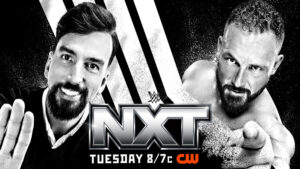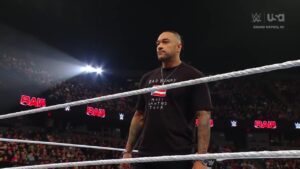Black trench coat, wide brim hat, fog that masks the floor – these are just a few of the classic hallmarks of The Undertaker. Often regarded as the greatest creation of World Wrestling Entertainment, the Dead Man has become the most enduring character in the company’s history. He has been immensely successful, boasting seven world championships, but his popularity transcends titles. Simply put, he is timeless.
The Undertaker wasn’t always the undead powerhouse that methodically approached the ring, however. From mid-2000 to late 2003, fans witnessed the path of destruction laid by an entirely different persona. Instead of slowly walking to the ring, he would speed down on his motorcycle. He would opt for the Last Ride, an elevated powerbomb, instead of relying on the Tombstone Piledriver. This was the latest in a line of reinventions of The Undertaker. Depending on who is asked, this might have been the best.
What caused this radical change in character, though? How did The Undertaker, a being with a penchant for the macabre, become a Harley-riding biker with a foul attitude? For a better understanding of how this personality came to be, we must go back all the way to 1999.
The Departure of The Undertaker

By 1999, The Undertaker was an established villain. He had become so engrossed in his own character that he believed himself to be a legitimately evil being. He conducted such heinous acts as kidnapping a young Stephanie McMahon to wed and attempting to embalm “Stone Cold” Steve Austin. Furthermore, he built a faction of evil-minded individuals known as The Ministry of Darkness. This group included future world champions including JBL, Christian, and Edge. This group became so destructive that it forced Austin to form a temporary alliance with his most hated rival, Vince McMahon.
During the summer, The Undertaker’s faction had disintegrated. From there, he began to team with The Big Show. The Unholy Alliance, as they were known, won the World Tag Team Championship twice. However, The Undertaker’s physical abilities grew limited due to injuries. He also began to show more human traits, which would play into his character transformation the following year. The Undertaker was off TV by September of 1999. This was done to allow him to heal from said injuries, including a groin and pec tear.
In the meantime, the stage was being set for an entirely new take on The Undertaker. On The Broken Skull Sessions, he told Austin that he felt “too handcuffed” for the company’s content. This wasn’t to say that The Undertaker hadn’t changed since his debut in 1990, as it developed in different ways, such as responding more to moves as opposed to being unphased like a zombie. From late 1999 to 2000, the Attitude Era was in full gear and it behooved the Dead Man to return with grit.
A Championship Main Event
While The Undertaker healed, The McMahon-Helmsley Faction was running roughshod on the World Wrestling Federation. Led by Triple H, who was the WWF Champion at the time, the group targeted the most beloved stars in the company. Enter The Rock, who had his own issues with the faction in question. The Game feuded with The People’s Champion throughout the spring, exchanging title victories along the way. Their feud would come to a head at Judgment Day, on May 21, 2000. On this night, from Freedom Hall in Louisville, Kentucky, The Rock defended the WWF Championship against Triple H in an iron man match.

The man to officiate this match was Shawn Michaels, who had been away from in-ring competition but still appeared from time to time. Furthermore, Triple H was seemingly adamant about winning the WWF Championship on his own, instructing The McMahon-Helmsley faction to remain backstage. As one would expect from a match between two hated rivals, it wouldn’t remain a clean battle. With Triple H focusing on the arm early on, as well as The Rock fighting back by focusing on the legs, these two stopped at nothing to one-up the other.
As the match progressed, falls were exchanged. The Rock secured the first with the Rock Bottom. Triple H planted him with a Pedigree to secure his own pinfall and managed to roll up the champion for a second cover. With Triple H securing his third pinfall, courtesy of a piledriver, the champion was on the ropes and it appeared that the WWF Championship was slipping from his grasp. However, The Rock rebounded with two consecutive wins, though one would come as a result of a disqualification when Triple H used a steel chair. The score wouldn’t remain even for long, as Triple H pinned the weakened champion for a fourth pin.
The match became more gruesome, Triple H being busted open prior to a fifth pin. By this time, the McMahon-Helmsley Faction interfered on behalf of the challenger. The Rock turned the tide with a fifth pin of his own, which prompted more aggressive interference from the faction in question. Michaels struggled to keep control of the match, as The Rock found himself at the mercy of the likes of X-Pac and Road Dogg. All hope seemed lost until a haunting nursery rhyme video played on the Titantron.
The Arrival of The Undertaker
“Are you scared?” Within the confines of Freedom Hall, the only emotion was excitement. Following the video in question, a long-haired figure rode toward the ring on a motorcycle. Donning a pair of shades, a bandana, and a long black coat, this was The Undertaker, reimagined. The crowd in the venue was beside itself as The Undertaker stepped through the ropes to confront The McMahon-Helmsley Faction. Within seconds, it became apparent that the corporate group wasn’t on his good side.
It didn’t take long for The Undertaker to dispose of several members of The McMahon-Helmsley Faction. One punch fell X-Pac, a high chokeslam neutralized Shane McMahon, and he was just getting started. As the final seconds of the match ticked, The Undertaker even decked Vince McMahon, showing that not even the chairman of the board was safe from this devastation. All the while, fans live in attendance and around the world ate every second up.

The Undertaker dropped Triple H with a Tombstone Piledriver, though this didn’t go unnoticed by Michaels. The Heartbreak Kid had no choice but to make the unpopular decision of disqualifying The Rock, awarding Triple H the final fall. On this night, Triple H became WWF Champion, but it was far from the talk of the wrestling world. The Undertaker was back and, more importantly, he returned with an entirely different aura. In short, this wasn’t the same individual that spoke about spirits, darkness, and the like in years past.
The Impact of the American Badass
It can be argued that The Undertaker returning as the American Badass was the right move at the right time. As stated earlier, the Attitude Era was hot. The most memorable characters, during this time, featured degrees of realism. In other words, the same Dead Man the fans knew over the years might not have thrived. Instead of returning as that very character, he came back with a more humanized presentation, though he was still more than a formidable fighter.
For proof of the realism of the American Badass, look no further than the various traits of the character. Case and point, the man behind the character was an enthusiast for motorcycles, including Harley-Davidson. During this time, The Undertaker was known for cruising down the ramp on a ride of his own. His offense changed as well. In addition to a new finisher in the form of the Last Ride, his arsenal became more strike-based. This was largely influenced by mixed martial arts, of which he was a fan. If the greatest characters were their real-life personalities with the dial turned up, the American Badass fit like a glove.

The Undertaker saw considerable success under this moniker, from 2000 up until 2003, when the character’s run ended. He won four the WWF World Tag Team Championship three times and the WCW World Tag Team Championship once. He teamed primarily with Kane to win these titles. The Undertaker was also a one-time Hardcore Champion, but his greatest victory occurred when he defeated Hulk Hogan, at Judgment Day 2002, for the WWE Undisputed Championship.
Whether he was known as the American Badass or Big Evil, this iteration of The Undertaker served as both a beloved hero and a nefarious villain. Much like his previous iterations, this would not last forever. More than three years after his return at Judgment Day 2000, he faced Vince McMahon in a Buried Alive Match at Survivor Series 2003. Due in large part to the assistance of Kane, McMahon was able to defeat The Undertaker. He would not be seen again until WrestleMania XX when he exacted revenge against his brother.

One of the most common debates among professional wrestling fans is regarding the “best” version of The Undertaker. Answers range from the original undead mortician to the leader of the Ministry of Darkness to the undead/biker fusion that debuted at WrestleMania XX. Regardless, it can’t be denied that the man that debuted at Judgment Day 2000 was unique. Not only did it complement the Attitude Era perfectly, but it served as one of the most memorable chapters in the career of The Undertaker.
Stay tuned to the Last Word on Pro Wrestling for more on this and other stories from around the world of wrestling, as they develop. You can always count on LWOPW to be on top of the major news in the wrestling world. WWE fan? Check out the WWE Network to fulfill all of your WWE needs!






